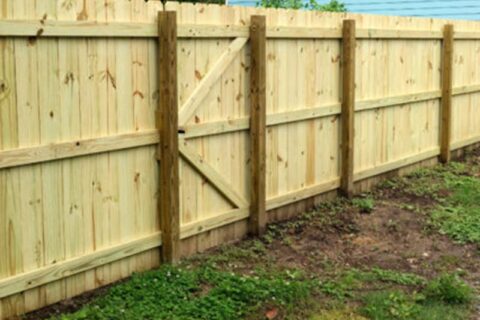A Complete Guide to Vinyl Fence Repair
There’s a reason why the global fencing industry is worth an estimated $28 billion. Fences not only protect your home and privacy, but they can also vastly improve the appearance of your home. Unfortunately, even the most well-built fence is prone to damage. For example, vinyl fencing is great at fighting off things like water and sunlight.
However, it’s prone to small holes and cracks over time. If you notice these problems in your vinyl fence, then don’t panic. You don’t need to replace it. Instead, some simple vinyl fence repair can fix the problem.
In this article, we’ll teach you everything you need to know about repairing your fence. Or, if you don’t feel comfortable with repairs, then we’ll help you find professionals to do it for you. Let’s get started!
How to Do Vinyl Fence Repair Yourself
If you feel like taking on a home improvement project, then you can try repairing your vinyl fence by yourself. However, you will need some tools and products to do it properly. Specifically, you will require a utility knife, 200-grit sandpaper, 400-grit sandpaper, rag, isopropyl alcohol, spray foam, auto body seal, and paint that matches the color of the fence.
1. Remove the Rough Edging
Typically, when a crack or hole appears in vinyl fencing there will be rough edges, burrs, and splinters along the side. It’s important to remove this rough edging since it can interfere with the final appearance of the fence.
Use your utility knife to trim along the inside, removing the rough edging as you go. We recommend cutting at a bevel angle for the best results. In the end, this will help create a smoother transition when you go into the fill.
2. Use Sandpaper to Remove the Damage
Once you’ve removed any rough edging it’s time to grab your 200-grit sandpaper. Slowly begin smoothing away the area. If you missed any roof spots, then now is the time to finish. Once you finish you can switch over to the 400-grit sandpaper. Continue sanding until the repair site is extra smooth.
3. Clean the Area
After you finish sanding it’s time to clean the area. You might be wondering, Is it really necessary to clean the repair site? The answer is yes. Chemicals and oil left behind can prevent the adhesive from properly binding the vinyl.
So, wipe away any physical debris with a rag. Then, soak the rag in isopropyl alcohol. Wipe down the outside and inside of the vinyl fence thoroughly until it’s clean.
4. Fill in the Hole With Spray Foam
Now it’s time to fill the hole. Insert the spray foam bottle into the vinyl fence hole. Begin spraying the foam slowly and gradually. Try your best not to overfill the interior space of the fence. If you do this it can cause warping and bulge within the plastic. Once you’ve filled the opening, then allow it to dry completely.
While you wait, wipe away any foam that may have spilled with the alcohol-soaked cloth. Also keep in mind that if the hole in your fence is more than eight inches, then you will need to create a backing. Otherwise, the fill can sag down and fall out of the opening.
5. Use Auto Body Filler to Seal the Opening
Once the foam dries, then it’s time to add auto body filler. This will both seal the opening, and make the repair spot blend in with the rest of the vinyl fence. Apply the filler around the opening with a knife, making sure to cover any potential gaps.
Once you finish wipe away any excess putty. After the auto body filler dries smooth out the area with the 400-grit sandpaper. Then wipe it down with a clean rag.
6. Touch up the Paint
Lastly, finish the repair site off with a fresh coat of paint. You should make sure that the color both matches the fence and is capable of sticking to vinyl. It should also be able to withstand rough weather. Once the vinyl fence is completed make sure that you regularly clean and maintain it to prevent damage in the future.
When Should You Contact a Contractor?
If you don’t feel comfortable repairing a vinyl fence yourself, then we recommend skipping right to a professional. This is a lot better than wasting time, effort, and money on a poor-looking fence repair. You should also consider a contractor when there is a lot of damage to be repaired. Or, if the damage is particularly extensive (like a car crashed through it).
There are a lot of benefits to hiring a contractor too. For one thing, they can probably do a much better job than you. As such, the final product will look a lot more attractive.
This is important if you want to increase the property value of your home. Potential buyers don’t want to see gaping holes in their new fence or subpar repair job. The other thing to consider is the time and effort saved. Just make sure that you find a contractor that does a good job at a fair price.
Need Help With Vinyl Fence Repair? Contact Florida State Fence
We hope this article helped you learn some helpful tips for vinyl fence repair. Unfortunately, not everyone has the skills or time to repair their fence on their own. The good news is that a professional can help you out. But how do you find a fencing company that you can trust? If you live in Florida, then look no further than Florida State Fence.
For over fifteen years we’ve been helping the communities of Tampa Bay and Lakeland with their fencing needs. Whether you need some simple repairs or a whole new fence, we can help you. Get in touch with us today to start enjoying your new and improved fencing.


